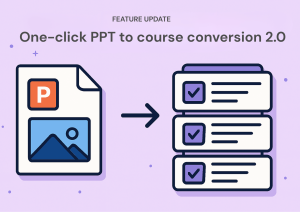
Top SCORM LMS Options: A Comprehensive Guide for 2024
- Author: Urban Rotar
- Published:

What does it mean to be SCORM compliant?
SCORM compliance indicates that an LMS or eLearning content, including a SCORM course, adheres to SCORM standards, ensuring interoperability and consistency. This compliance is crucial for ensuring that the content can be reused and shared across different systems without compatibility issues. Ensuring SCORM compliance also means that the learning content meets industry standards for functionality and interoperability, which is essential for providing a seamless learning experience.
How can I ensure my LMS supports various SCORM versions?
Verify that your LMS is certified to support multiple SCORM versions, such as SCORM 1.2 and SCORM 2004. Check for certification from recognized organizations and review user feedback to ensure compatibility.
What are the benefits of using SCORM compliant authoring tools?
SCORM compliant authoring tools facilitate the creation of interactive and engaging eLearning content that meets SCORM standards. These tools ensure interoperability, enable detailed tracking and reporting, and enhance the overall learning experience through features like quizzes and multimedia elements.
What are the alternatives to SCORM?
lternatives to SCORM include xAPI (Experience API) and cmi5, which offer more advanced tracking and reporting capabilities. These alternatives provide additional features and flexibility, making them suitable for more complex eLearning scenarios. For instance, xAPI can track a wider range of learning experiences, including offline activities and informal learning, providing a more comprehensive view of learner progress. cmi5 combines the best features of SCORM and xAPI, offering advanced tracking capabilities and improved interoperability. SCORM courses, on the other hand, standardize the way the courses for eLearning are created and launched, ensuring compatibility across different eLearning platforms.
Key Takeaways - SCORM LMS:
- SCORM ensures interoperability and standardization of eLearning content across different LMS platforms.
- SCORM compliant LMSs provide robust tracking and reporting features.
- SCORM authoring tools create interactive and engaging eLearning content.
- Choosing a SCORM compliant LMS enhances the consistency and effectiveness of eLearning programs.
- Key SCORM LMS options for 2024 include CourslyAI, iSpring Learn, and SAP Litmos.
What is SCORM?
Definition and Meaning
SCORM stands for Shareable Content Object Reference Model. It is a set of standards for eLearning software products that standardizes the way SCORM courses are created and launched. SCORM allows different eLearning courses to interact seamlessly with various LMS platforms, ensuring a consistent and reliable learning experience across different systems. By adhering to SCORM standards, educational content can be reused and shared efficiently, promoting a flexible and scalable approach to eLearning. This adaptability is crucial as it ensures that content created on one system can be used on another without significant modifications, which is essential for maintaining consistency and reducing redundancy in content creation.
SCORM provides a framework for how online learning content and LMS platforms interact. It defines how content should be packaged, communicated, and tracked, ensuring that all elements of an eLearning course work together harmoniously. This framework not only facilitates the creation of standardized content but also enhances its longevity and usability, making SCORM an invaluable asset in the eLearning industry.
Benefits of SCORM Compliance
Importance of Interoperability
One of the primary benefits of SCORM compliance is the interoperability it offers. SCORM compliant content integrates seamlessly with various LMS platforms, allowing for easy reuse and sharing of SCORM compliant courses. This interoperability simplifies the process of creating and managing eLearning content, making it a preferred choice for many educational institutions and corporations. SCORM compliance also enhances the learner’s experience by providing a uniform interface and functionality, regardless of the LMS used. This uniformity is particularly beneficial for organizations that employ multiple LMS platforms, as it ensures that all users have a similar learning experience, thereby improving engagement and comprehension.
Interoperability also reduces the technical barriers for deploying eLearning content across different platforms. By following SCORM standards, content creators can ensure that their materials will work seamlessly on any LMS compliant with SCORM. This flexibility is especially important for organizations that need to deliver training across various environments, such as educational institutions, corporate training programs, and government agencies. The ability to reuse content without modification saves time and resources, making the development process more efficient and cost-effective.

Enhanced Learning Experience
SCORM compliance ensures that eLearning content is consistent and reliable. By following a standardized format, SCORM content delivers a uniform learning experience across different devices and platforms. Creating a SCORM course involves using authoring tools to develop interactive and engaging eLearning content that meets these standards. This consistency is critical for tracking learner progress and performance, providing educators with valuable insights into the effectiveness of their courses. Additionally, SCORM compliant content can incorporate advanced features such as interactive simulations, quizzes, and assessments, which can significantly enhance the learning experience. These interactive elements engage learners more effectively, promoting better retention and understanding of the material.
The use of interactive elements in SCORM content transforms passive learning into an active experience, which is known to improve learner outcomes. Features like branching scenarios, drag-and-drop activities, and multimedia content not only make learning more engaging but also cater to different learning styles. This adaptability ensures that all learners, regardless of their preferred learning methods, can benefit from the training material. Furthermore, the ability to track detailed metrics such as time spent on each activity, quiz scores, and completion rates allows educators to tailor their instruction to meet the needs of individual learners, thereby enhancing the overall effectiveness of the training program.

Choosing a SCORM Compliant LMS
Key Considerations
When selecting a SCORM compliant LMS, several factors need to be considered:
SCORM compliance and certification: Ensure that the LMS is certified to support SCORM standards. This certification is crucial as it guarantees that the LMS can effectively handle SCORM content without compatibility issues.
Support for different SCORM versions: It’s essential to choose an LMS that supports various SCORM versions, such as SCORM 1.2 and SCORM 2004. Different versions offer unique features and improvements, so support for multiple versions ensures flexibility.
Ease of importing and tracking SCORM content: The LMS should facilitate easy import and tracking of SCORM content, allowing administrators to monitor progress and performance effortlessly.
Compatibility with popular authoring tools: The LMS should be compatible with widely-used authoring tools to create and manage SCORM content effectively. Ideally, it should support a SCORM compliant authoring tool to ensure seamless integration and ease of use. This compatibility ensures that content creators can use their preferred tools without worrying about integration issues.
Reporting and analytics capabilities: Robust reporting and analytics features are crucial for monitoring learner progress and course effectiveness. These capabilities allow educators to make data-driven decisions to improve their eLearning programs.
Additionally, consider the scalability of the LMS. As your organization grows, the LMS should be able to accommodate an increasing number of users and courses without compromising performance. Look for features such as cloud-based deployment, which can offer greater flexibility and scalability. Also, evaluate the level of customer support and training provided by the LMS vendor, as this can significantly impact the implementation and ongoing management of the system.
Popular SCORM Compliant LMS Options
Several SCORM compliant LMS options are popular in 2024, including:
SCORM compliant LMSs are crucial for providing a seamless and effective learning experience, as they ensure compatibility and standardization across different eLearning platforms.
CourslyAI: Known for its user-friendly interface and robust support for SCORM content, CourslyAI provides comprehensive solutions for various eLearning needs.
iSpring Learn: Recognized for its ease of use and excellent support for SCORM content, iSpring Learn is a top choice for many organizations.
LearnUpon: Offers comprehensive SCORM compliance and powerful tracking features, making it suitable for diverse educational settings.
SAP Litmos: Provides extensive reporting capabilities and supports various SCORM versions, ensuring flexibility and detailed insights.
Docebo: Known for its flexibility and compatibility with multiple authoring tools, Docebo is a versatile option for eLearning programs.
Skilljar: Features excellent integration options and user data tracking, making it ideal for organizations looking to streamline their training processes.
Each of these LMS platforms offers unique features and benefits, catering to different needs and preferences. For example, CourslyAI is particularly noted for its AI-driven analytics, which can provide deeper insights into learner behaviors and outcomes. iSpring Learn stands out for its intuitive interface, making it easy for both administrators and learners to navigate. LearnUpon excels in providing a comprehensive learning ecosystem with strong integrations and customization options. SAP Litmos offers extensive support for global enterprises with its multilingual and multi-currency capabilities. Docebo is highly praised for its adaptability, supporting a wide range of eLearning initiatives from compliance training to professional development. Skilljar focuses on customer education and is designed to help businesses create effective training programs for their clients.
SCORM Authoring Tools and Content Creation
Overview of SCORM Authoring Tools
Creating eLearning that is compliant with SCORM content requires a SCORM compliant authoring tool. These tools help design interactive simulations, quizzes, assessments, and more. Some of the popular SCORM authoring tools include:
CourslyAI: Known for its advanced features and AI-driven capabilities, CourslyAI allows users to create highly engaging and interactive SCORM compliant courses with ease.
Articulate Storyline: Known for its intuitive design and interactive features, Articulate Storyline makes it easy to create engaging eLearning content.
Adobe Captivate: Offers advanced multimedia capabilities and robust SCORM support, allowing creators to develop highly interactive courses.
Lectora Inspire: Features a wide range of templates and interactive elements, enabling the creation of diverse eLearning materials.
These authoring tools not only facilitate the creation of SCORM compliant content but also ensure that the content is engaging and interactive, promoting better learning outcomes. They offer various multimedia elements, including videos, animations, and simulations, which can be easily integrated into the content to enhance the learning experience.
Features of SCORM Authoring Tools
These tools enable the creation of rich, interactive eLearning content using an authoring tool that is compliant with SCORM. They support various multimedia elements, including videos, animations, and simulations, ensuring an engaging learning experience. Additionally, they offer features like quizzes and assessments, enhancing the effectiveness of eLearning courses. These features are designed to engage learners actively, promoting better retention and understanding of the material. Moreover, these tools often come with built-in templates and themes, allowing content creators to design visually appealing courses without needing advanced design skills.
For instance, CourslyAI leverages artificial intelligence to provide suggestions for improving course content, making it easier for instructors to create effective and engaging eLearning materials. Articulate Storyline offers a range of interactive elements such as drag-and-drop interactions and branching scenarios that allow learners to explore different outcomes based on their choices. Adobe Captivate supports virtual reality (VR) and augmented reality (AR) content, providing immersive learning experiences that can significantly enhance learner engagement. Lectora Inspire includes built-in libraries of assets and templates, simplifying the content creation process and ensuring that the final product is both professional and effective.

SCORM LMS Features and Functionality
SCORM Runtime Environment (RTE) Support
A key feature of SCORM compliant LMSs is their support for the SCORM Runtime Environment (RTE). This support ensures seamless communication between SCORM content and the LMS, facilitating accurate tracking and reporting of learner progress and performance. The RTE support is essential for ensuring that all interactions and data exchanges between the content and the LMS are handled smoothly, providing a reliable learning experience. This seamless communication is crucial for maintaining the integrity of the learning process and ensuring that all learner interactions are accurately recorded and reported.
The SCORM Runtime Environment (RTE) acts as a bridge between the SCORM content and the LMS, ensuring that data such as quiz results, progress tracking, and completion statuses are accurately transmitted. This seamless interaction is fundamental for providing a consistent learning experience across different devices and platforms. By supporting the SCORM RTE, an LMS can offer detailed insights into learner behaviors, which can be used to tailor educational content to better meet the needs of students. This capability is especially important in large-scale eLearning implementations where tracking individual progress and performance is crucial for overall success.
User Data Submission and Tracking
LMS platforms that are compšliant with SCORM track learner progress and performance effectively. They submit user data to the LMS for analysis and reporting, providing educators with valuable insights. This tracking capability is essential for assessing the effectiveness of eLearning content and making necessary improvements. Detailed tracking and reporting features within a SCORM course enable educators to monitor individual learner progress, identify areas where learners may be struggling, and adjust the content accordingly to improve learning outcomes. This data-driven approach helps in creating more effective and targeted eLearning programs.
The ability to track and report on a wide range of metrics, such as time spent on each module, scores from quizzes and assessments, and completion rates, allows educators to gain a comprehensive understanding of how learners are engaging with the content. This information can be used to make data-driven decisions about instructional design, course content, and overall training strategy. Additionally, advanced reporting features often include customizable dashboards and visualizations, making it easier for educators and administrators to interpret the data and take actionable steps to enhance the learning experience.

Additional Features and Considerations
Modern LMS platforms that are compliant with SCORM offer additional features to enhance the learning experience. The importance of SCORM compliant LMSs lies in their ability to provide advanced features, ease of use, and robust tracking capabilities, which are essential for effective eLearning.
Content scaling for mobile devices: Ensures that eLearning content is accessible on various devices, including smartphones and tablets. This accessibility is crucial for learners who prefer to study on the go.
Support for multiple languages and currencies: Facilitates global reach and accessibility, making it easier for organizations to deliver training to a diverse audience. This feature is particularly important for multinational corporations and educational institutions that serve students from different countries.
Integration with other eLearning tools and platforms: Allows for seamless integration with other educational technologies, enhancing overall functionality. This integration is vital for creating a cohesive eLearning ecosystem that supports various learning activities and tools.
These additional features ensure that the LMS can meet the diverse needs of learners and organizations, providing a flexible and comprehensive solution for eLearning. By offering these advanced features, SCORM compliant LMS platforms ensure that they can support a wide range of eLearning scenarios, from simple courses to complex training programs. The ability to scale content for mobile devices, support multiple languages and currencies, and integrate with other eLearning tools and platforms makes these LMS platforms versatile and adaptable, capable of meeting the evolving needs of the eLearning landscape.

Conclusion – SCORM LMS
In summary, SCORM compliance is a crucial factor in ensuring the seamless integration of eLearning content with LMS platforms. Using SCORM compliant authoring tools is essential for creating SCORM compliant content. Choosing the right SCORM compliant LMS and authoring tool is essential for successful eLearning implementation. SCORM compliant LMSs provide a seamless and effective learning experience. By considering key features and functionalities, educators and organizations can select an LMS that meets their specific needs and provides a robust, effective learning experience. SCORM compliance not only ensures consistency and interoperability but also enhances the overall quality and engagement of eLearning content. This comprehensive guide should serve as a valuable resource for those looking to implement or upgrade their eLearning systems, helping them make informed decisions that will benefit both learners and educators alike.

SCORM has established itself as an industry standard in the eLearning sector, providing a reliable framework for the development, delivery, and tracking of online learning materials. The ability to create, share, and reuse content efficiently makes SCORM an indispensable tool for educators and organizations worldwide. By leveraging SCORM compliant LMS platforms and authoring tools, you can ensure that your eLearning initiatives are effective, engaging, and capable of delivering high-quality educational experiences to your audience.
Incorporating SCORM compliance into your eLearning strategy not only simplifies the process of managing and delivering content but also ensures that your learners have access to the best possible educational resources. As the eLearning industry continues to evolve, staying up-to-date with SCORM standards and advancements will be crucial for maintaining the relevance and effectiveness of your educational programs. Whether you are a seasoned eLearning professional or just beginning to explore the possibilities of online education, understanding and implementing SCORM compliance will be a key factor in achieving your training and educational goals.



